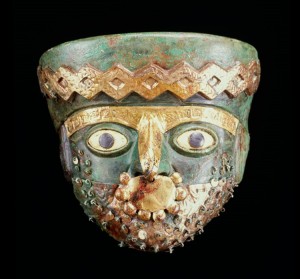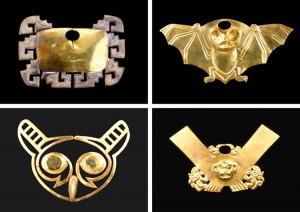Golden Kingdoms at the Met
March 7, 2018
Last week, on February 28, an exhibition of artwork of the ancient Americas opened at the Metropolitan Museum of Art in New York City. Called “Golden Kingdoms: Luxury & Legacy in the Ancient Americas,” the exhibition features the arts of the Aztec, the Inca, and other pre-Columbian cultures of Mexico and Central and South America. American Indian art created before A.D. 1500 is called pre-Columbian because it was produced before Christopher Columbus arrived in the New World in 1492.

The Golden Kingdoms exhibition includes this burial mask recovered from an ancient site known as Dos Cabezas on the northern Pacific coast of Peru. The gilded copper mask features eyes inlaid with shell and violet stone. The mask covered the face of a young man–no doubt someone of significance–wearing gold nose ornaments (see image below). Credit: Burial mask (A.D. 525–550), gilded copper, shell, and stone; Museo de Sitio de Chan Chan, Perú; Christopher B. Donnan/Metropolitan Museum of Art
Gold working in the ancient Americas began in the Andean cultures of South America and later developed farther north in Mesoamerica (what is now Central America and Mexico). Gold—considered an earthly remnant of the divine sun—and other precious metals were used more for decoration and ritual than for currency, tools, or weapons. Fine arts in the ancient Americas often connected people to ancestors, to the natural world around them, and to the gods and legends of their individual mythologies. Decorative objects were also used used in games and music and to celebrate fine harvests or rites of passage.
The Golden Kingdoms exhibition pays particular tribute to gold working. However, it also shows numerous works of bronze, copper, and silver, as well as precious objects made of cinnabar, jade, malachite, sea shell, turquoise, and feathers—materials often considered more valuable than gold. Noble textiles and fine pottery are also featured in the exhibit, which explores how materials were selected and transformed into art, what gave the objects meaning, and how they were used in sacred rituals.

These nose ornaments on display at the Met were found beneath the burial mask seen above. The deceased young man wore a rectangular gold ornament with a silver border. The hammered gold owl was compressed and placed in his mouth. The other ornaments depict a bat and a monkey. Credit: Clockwise from top left: Nose ornament (A.D. 525–550), gold and silver; Nose ornament (A.D. 525–550), Gold; Nose ornament (A.D. 525–550), Gold and stone; Nose ornament (A.D. 525–550), Gold; (Museo de Sitio de Chan Chan, Perú/Christopher B. Donnan/Metropolitan Museum of Art)
The Met exhibition features more than 300 works of newly discovered archaeological finds as well as established masterpieces from museums in Europe, Latin America, and the United States. Objects on display include bells, belts, collars, masks, and various forms of jewelry. “Golden Kingdoms: Luxury & Legacy in the Ancient Americas” runs through May 28.


